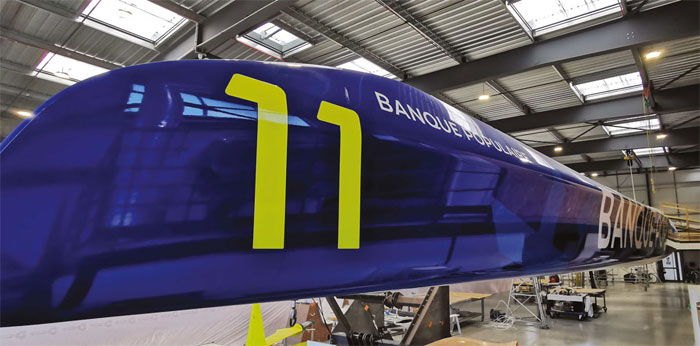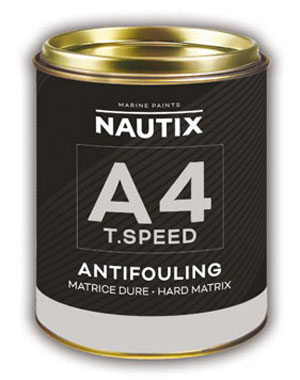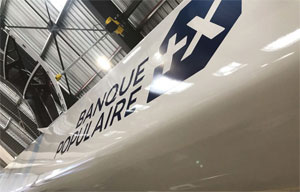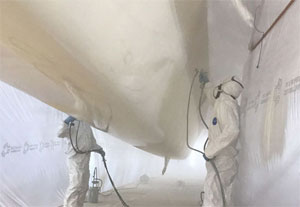

The world’s fastest offshore racers require very special and specific types of antifouling, hull and deck paint… plus about 5,000 hours of highly skilled labour to apply them correctly…
The relaunch of the Banque Populaire Ultim will be followed by offshore training including a round trip to South Africa to validate the changes made during the winter works and to compile as much data as possible about the performance of the boat. The Rolex Fastnet will see her raced in anger and then skipper Armel le Cléac'h is due to sail “false solo” (racing with two crew but only one person actually sailing the boat, often carried out for safety reasons when solo skippers are training) in the Arkéa Ultim Challenge, which will set off from Brest on 7 January 2024. The equivalent of the Vendée Globe, sailed on Ultims, this is the colossal challenge ahead.
Several key parts of meeting these challenges will have been addressed before the boat leaves the base. Of these challenges, good surface glide and abrasion resistance are both absolutely critical. Pierre-Emmanuel Hérissé, technical director of Banque Populaire and a major player in the ocean racing community for a quarter of a century says, ‘the BP team has always collaborated with Nautix for paints and coatings. We appreciate the reliability of the company and its expertise. In addition to its proximity, Nautix is a 15-minute drive from our base in Lorient. We have always worked with them, from the Figaro to the Ultim, for underwater paints, non-slip deck paints and also lacquers.
‘We subcontract the task of painting to Blackfiber, they have one or two people permanently at our site. We define the maintenance and refit schedules and we rely on their know-how for everything coatingsrelated. Team Banque Populaire has two buildings sited in Lorient. The first, 400m2, was intended for the ORMA trimarans. The other, twice as large, houses the Ultim.

‘The maxi tri is often inside the shed. We spend our life dismantling, reassembling the appendages, to maintain them, pamper them, sand them and so on. It takes a lot of work to keep the appendages at peak performance in terms of good glide and abrasion resistance. We do the preparation and Blackfiber comes to apply the paint, from the primer to the final topcoat’.
The appendages are becoming bigger and more and more stressed; the boats are going faster and faster offshore and this causes violent impacts. Hard matrix paints meet these two requirements of abrasion and impact resistance. It is a timeconsuming task because it is often necessary to strip the coatings back and recoat to regain an optimal finish and preserve the cleanest flows possible.
Hérissé says. Other teams lacquer their boat completely, topsides and under-water sections. ‘But not us,’ says Hérissé, ‘we continue to use antifouling on the underbody to avoid tedious time spent on underwater cleaning work’. The antifouling does not eliminate cleaning dives. A BP diver works every week when the boat is in the water and this allows an application on the underbody only once a year.
Guillaume Helfer has been working for 20 years around the submarine base in Lorient where the best of the world’s ocean racing fleet is located. Originally, Helfer was part of racing teams but created his own company, Blackfiber, 15 years ago, which employs five to six very busy people. ‘We handle the painting cycle on the new boats (shaping, priming, paint application) and the maintenance year-round of the racing sailboats, which are largely on the site of Lorient La Base’ he explains. ‘For us the choice of Nautix is both simple and logical: they are an easy company to work with and they have developed high quality products. And when you work with good products, you usually stay with them.’
‘We use all their epoxy primers applied to carbon fibre as soon as the hull leaves the mould,’ he says. ‘Mechanical and manual sanding removes surface deformations. Then we apply the antifouling A4 T.Speed which has a little Teflon, and traditional lacquer from 15cm above the waterline.’
‘On the Ultim Banque Populaire XI, and now on all ocean sailing boats and appendages (rudders, foils, dinghies), we use a special Nautix product that has an exceptionally hard matrix, the NX 194. This product is based on epoxy polyamide resin and contains fine, hard particles. It is very resistant to abrasion and able to withstand enormous pressures, especially the friction of the foils in their wells, and violent impact in the marine environment due to the very high speed of the boats.

Above: in total Banque Populaire XI has 200 to 250 litres of deck paint, antifoul and gloss paint on her hull, all supplied by Nautix.
Below: the painting and sanding of Banque Pop involved 5,000 hours of work in a temperature and humidity controlled environment

‘The application is made in the customer’s site, and under cover, so that an adequate temperature and humidity can be achieved, while protecting the surface from dust. All applications are spray painted. An Ultim is 32 metres long and 23 metres wide and has three hulls. We use a lot of paint. Overall, I would say about 200/250 litres, across all the coating products. Though a significant quantity of the coatings disappears with successive sanding cycles, the total weight of the paint applied is around 150kg, including about 40 litres of white lacquer and about 30 litres of blue lacquer on Banque Populaire XI. In its entirety, from the exit of mould until the delivery on the launch day, the painting represented 5,000 hours of work on this maxi trimaran’ he adds.
Asked what differentiates the treatment of a racing boat from that of a cruising boat, Helfer points to the weight, which is the enemy when performance takes precedence. ‘We don’t push the finish as much as we do on cruising boats, especially on large luxury yachts where we use tons of coats to get an impeccable look,’ he says.
Matthieu Taburet, commercial director of Nautix Marine Paint explains that his company was born with offshore racing in the 90s. ‘It is our roots and also a passion’ he says. Located between Lorient and Port La-Forêt, the company has developed a natural proximity with the world’s foremost ocean racers. ‘Their specific expectations and their technical views on hulls and glide have enabled us to develop our products quickly to meet their performance objectives,’ Taburet says. The priority for racing is performance. Performance in terms of protection of the structure and in particular the carbon composites, performance in terms of glide, performance in terms of specific technical paintwork, but also performance in terms of the environment.
‘In a new project or a refit, all of these points are addressed upstream so we can propose the most suitable solution for the boat and the skipper. In concrete terms, a skipper who has invested in a second-hand Imoca or Class 40 will not have the same expectations in terms of painting as a team building a new boat. For example, he will choose an antifouling rather than a paint dedicated to gliding, such as White T.Speed, to be able to take the boat in hand and go sailing without maintenance constraints. Similarly, above the waterline, he will need to select easy-care paints to be able to stick to the boat quickly according to the sponsors that come along. It is all these elements that we take into account to find the best compromise together,’ Taburet says.
In a project, painting is often not anticipated. Nautix is used to this. However the painting company always tries to be involved early on in the process, to evaluate the options as well as possible and also to be ready for production. ‘The applicators are our customers and our daily contacts. We listen to their expertise, which allows us to improve or develop new products. We also need to know how to correct, reframe or change habits because the chemistry of paint has physical limits. Painters are players and try their own solutions in order to go faster or to have super smooth finishes. Their uses can be relevant but also sometimes borderline. It is then up to us, the formulator, to explain to them the cause of the failures. Hence the need for mutual trust,’ he concludes.
Click here for more information on Nautix »
We invite you to read on and find out for yourself why Seahorse is the most highly-rated source in the world for anyone who is serious about their racing.
To read on simply SIGN up NOW
Take advantage of our very best subscription offer or order a single copy of this issue of Seahorse.
Online at:
www.seahorse.co.uk/shop and use the code TECH20
Or for iPad simply download the Seahorse App at the iTunes store


